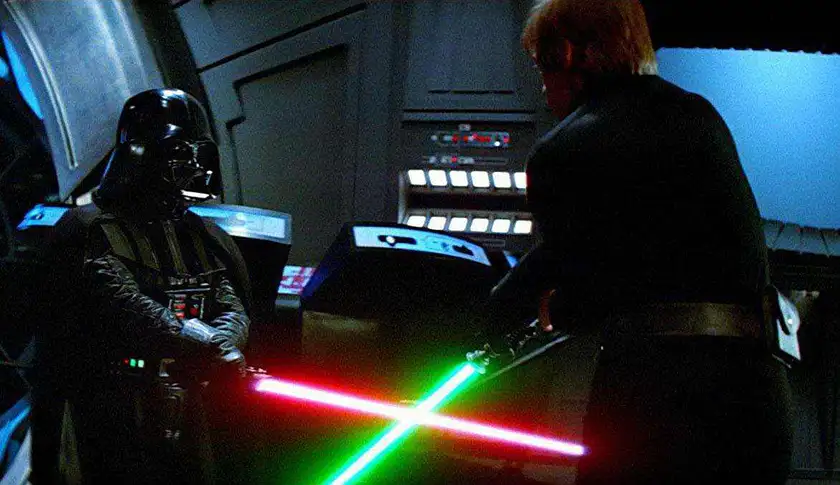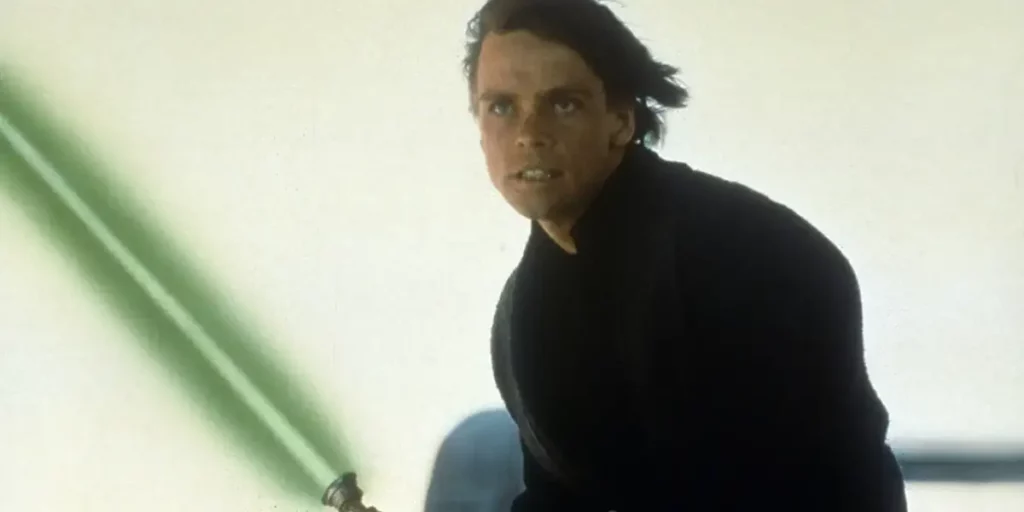Episode VI – Return of the Jedi a nearly perfect culmination of all that makes Star Wars revolutionary, and a further expansion of George Lucas’s brilliant worldbuilding.
Director: Richard Marquand
Genre: Sci-Fi
Run Time: 131′
US Release: May 25, 1983
UK Release: June 2, 1983
Where to watch: on digital & VOD
“There is still good in him.”
The realization that Luke Skywalker (Mark Hamill) comes to about confronting his father in the Star Wars trilogy’s climactic installment is perhaps the film’s defining theme. In Star Wars: Episode VI – Return of the Jedi (1983), the iconic sci-fi space opera comes to a head with higher stakes than ever before.
Luke Skywalker and the Rebellion seek to destroy yet another Death Star project led by Emperor Palpatine and Darth Vader. It is a nearly perfect culmination of all that makes Star Wars revolutionary, and a further expansion of George Lucas’s brilliant worldbuilding.
George Lucas did not direct The Empire Strikes Back (1981), nor did he direct Return of the Jedi; his writing and influence throughout the filming process assuredly made the trilogy the captivating and epic experience that myriad Star Wars fans admire today. George Lucas is one of the greatest visionary filmmakers in the last 40 years, and he proved that he could create a unique and fascinating world while trusting others to direct the films.
Episode VI – Return of the Jedi sees the iconic threesome of Han Solo (Harrison Ford), Leia (Carrie Fisher), Luke Skywalker working together better than they did in the first two films. While Han is the skeptic, Leia the wise planner, and Luke the naive jedi, Return of the Jedi shows just how much they grow and become an unstoppable force against the Empire. Their chemistry on-screen is unrivaled in sci-fi; not even newer Star Wars films have been able to harness the magic that Fisher, Ford, and Hamill created with the original trilogy.
Return of the Jedi is not a perfect film; it suffers some of the same characteristic flaws of the entire trilogy, such as a poor script and questionable writing decisions. One such decision is the infamous Ewok debate. Wicket actor Warwick Davis told SlashFilm he understands why fans are divided over the cute-but-dangerous animals. He also notes that Lucas’s idea of “primitive creatures bringing down the technologically advanced Empire” was well executed, even if the creatures doing so ended up being more adorable than intimidating. Nevertheless, Ewoks and the forest moon of Endor are further proof of Lucas’s vast creativity in the Star Wars universe, even if the end result is not as many fans would have hoped.

One of the most satisfying aspects of Episode VI is Luke’s final battle against Darth Vader and the Emperor. His training with Ben Kenobi (Alec Guinness) and Yoda in the first two films led to the riveting moments in which he opposed the two strongest sith in the galaxy aboard the planet-destroying Death Star. The fight choreography in these scenes is some of the best in the trilogy, and serves as a vehicle for the deciding moment in Luke’s character arc: does he give into his anger and use the dark side of the force, or cling to the force for good? Episode VI is a perfect finish to the Star Wars trilogy because it shows that no one is ever truly lost: Darth Vader’s eventual sacrifice to save his son is a triumphant and emotional payoff.
While Lucas eventually went back to remaster and change certain scenes of each film in the original trilogy, the foundational elements of Episode VI are timeless and will go down in history as some of the greatest moments in cinema. Lucas’s ingenuity with practical effects, worldbuilding, and character development make Return of the Jedi an exciting, emotional climax to the most memorable sci-fi series of all time. Its script and execution may be faulty at times, but there is no better way to save the galaxy and conclude the trilogy than this.
Star Wars: Episode VI – Return of the Jedi is now available to watch on digital and on demand.

